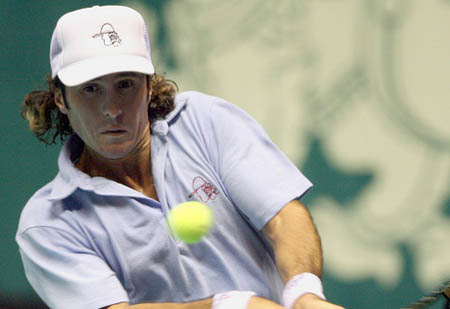By Charles Bricker
It was all done by the ATP rule book, which states clearly that wild cards — for both the main draw and qualifying — are at the complete discretion of the tournament.

But that didn’t make it any less confounding after executives of this week’s BNP Paribas Open in Indian Wells, Calif., chose to dole out three of their five qualifying tournament cards to aging, unknown players and a fourth to 35-year-old Vince Spadea, who has played only one match this year, who has lost six straight dating back to 2009 and who is probably near retirement after winning only two of his last 16 matches.
As is sometimes the case on the ATP and WTA tours, wild cards go not to promising juniors or older former champions, but as favors to players who are known to tournament officials.
None of the five who received qualifying wild cards at Indian Wells, predictably, made it through the required two rounds into the main draw, though 18-year-old Serbian Filip Krajinovic, the only one of the five for whom a strong wild card argument could be made, did win a round before going out to American Tim Smyczek on Wednesday.
You might feel that wild cards should be disbursed purely on the basis of performance — past performance in the case of older former stars. But the people who control the cards aren’t required to make their case to anyone. It’s at their discretion, which is why No. 772-ranked Roman Borvanov received a card into the qualifying.
Borvanov’s ranking wouldn’t be an issue if he was a 17-year-old junior who had just turned pro and who looked as if he had a strong future in tennis. But Borvanov, who played for the University of Portland, will be 28 years old on March 31. He’s so obscure that the official ATP website has virtually no personal information on him, including whether he plays righthanded or left.
“He’s got a real following around here,” tournament director Steve Simon explained. That local connection was Borvanov’s ticket to a free ride into the quallies, ahead of several promising U.S. teenagers who could have used the card.
Borvanov lost to Lu Yen-Hsun 6-3, 6-4 in the opening round, winning only six of Lu’s 43 service points. But Borvanov, born in Moldava and now a U.S. citizen, wasn’t the only anonymous tennis pro to get a wild card into Indian Wells qualifying. Here are the others:
* Brian Battistone, 30, of Las Vegas. He was No. 853 last November, but has since lost all his points, which means he no longer has a singles ranking. He is, however, No. 245 in doubles. Despite his years as a pro, he’s never played a regular, main draw ATP singles match. Lost to American Jesse Witten 3-6, 6-2, 6-4 in the first round.
* Jose de Armas of Venezuela, 28, and No. 416. He was once as high as No. 236. This season he’s reached the semis and quarters of two Futures events, which are the third and final level of tournament quality on the men’s tour. He’s never played an Indian Wells main draw. Lost to Bjorn Phau 6-2, 7-6 (4) in the opening round.
* Spadea of Boca Raton, Fla., 35, and ranked No. 410. He has played only one match this year, losing at Delray Beach, Fl., where he got a wild card into the main draw because of the tournament’s proximity to his home. Spadea was an Indian Wells semifinalist in 2003, but, overall, has only a 9-12 record at the tournament. Lost to Thiago Alves 6-1, 6-7 (4), 6-0 in the first round.
* Krajinovic of Serbia, 18, and ranked No. 351. He reached No. 6 as a junior and has had a couple of wins this season over players ranked in the 100s. He’s a significant prospect who justifies a wild card based on his ability. Defeated former French Open winner Gaston Gaudio 6-7 (2), 7-5, 7-5 in the opening round, then lost to Smyczek 6-1, 6-0.
The Indian Wells 1000 is followed in two weeks by the Sony Ericsson Open 1000 on Key Biscayne, Fl., where they appear to have a different philosophy about giving out wild cards.
In 2009, Key Biscayne executives similarly had five wild cards to give in qualifying. They went to former Grand Slam winners Gaudio and Thomas Johansson, both of whom had seen their rankings plummet because of injuries; to young U.S. prospects Alex Domijan of Tampa and Michael McClune of Irvine, Calif.; and to another American, Taylor Dent, a former No. 21 player who had fought back from two back surgeries and two and a half years of inactivity to get back into pro tennis.
The Sony Ericsson Open adheres to the same philosophy as most tournaments, which give wild cards to (a) strong junior prospects of any nationality and (b) former champions with high name recognition.
But when a tournament has complete discretion, a wild card can be given for any reason.
In 1999, Jan-Michael Gambill had the greatest tournament of his career, beating No. 1 Pete Sampras, then Andre Agassi in the semis and Lleyton Hewitt in the final to win Scottsdale, Ariz. A year later, beset by injury, his declining ranking of 86 was too low to get directly into the tournament, so he asked for a wild card. The defending champion was denied and the three main draw cards given to clients of IMG, which owned the tournament. Gambill was represented by a different firm.
It’s like the rule book says. Complete discretion.
Charles Bricker can be reached at nflwriterr@aol.com
